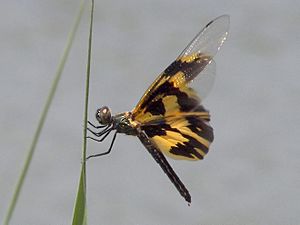Flutterers
Quick facts for kids Flutterers |
|
|---|---|
 |
|
| Rhyothemis variegata | |
| Scientific classification |
|
| Kingdom: | Animalia |
| Phylum: | Arthropoda |
| Class: | Insecta |
| Order: | Odonata |
| Infraorder: | Anisoptera |
| Family: | Libellulidae |
| Genus: | Rhyothemis Hagen, 1867 |
Rhyothemis is a genus of dragonfly in the family Libellulidae. These amazing insects are often called Flutterers because of how they fly. You can find Rhyothemis species in many parts of the world, including Africa, Asia, Australia, and the Pacific region. They are known for their beautiful, often colorful wings.
Contents
What are Flutterers?
Flutterers are a special type of dragonfly. Dragonflies are insects that have been around for millions of years! They are known for their large eyes, strong bodies, and two pairs of clear, strong wings. Flutterers get their name because their wings often have patterns or colors that make them look like they are fluttering when they fly.
Where Flutterers Live
You can find Flutterers in many warm parts of the world. They live near water, like ponds, lakes, and slow-moving rivers. This is because young dragonflies, called nymphs, live in the water. Adult Flutterers need water to lay their eggs.
Flutterer Features
Flutterers, like all dragonflies, have some cool features:
- Big Eyes: They have huge compound eyes that help them see almost all around them. This is great for hunting other insects!
- Strong Wings: Their two pairs of wings can move separately. This lets them fly super fast, hover in place, or even fly backward.
- Amazing Hunters: Flutterers are expert hunters. They catch other flying insects, like mosquitoes and flies, right out of the air. They are very helpful because they eat insects that can bother humans.
Life Cycle of a Flutterer
The life of a Flutterer starts in the water.
- Eggs: A female Flutterer lays her eggs in or near water.
- Nymphs: When the eggs hatch, tiny creatures called nymphs come out. These nymphs live underwater for weeks, months, or even years! They breathe using gills and hunt small water creatures.
- Adults: When a nymph is ready, it crawls out of the water, often onto a plant stem. Its skin splits open, and the adult Flutterer emerges. It takes some time for its wings to harden and its colors to fully develop. Once ready, the adult Flutterer flies off to hunt and find a mate, starting the cycle again.
Types of Flutterers
The Rhyothemis genus includes many different species. Each one has its own unique look, especially in its wing patterns and colors. Some are very common, while others are rarer.
- Rhyothemis amaryllis Selys, 1878
- Rhyothemis aterrima Selys, 1891
- Rhyothemis braganza Karsch, 1890
- Rhyothemis cognata (Rambur, 1842)
- Rhyothemis fulgens Kirby, 1889
- Rhyothemis fuliginosa Selys, 1883
- Rhyothemis graphiptera (Rambur, 1842) - Graphic Flutterer or Banded Flutterer or Small Pond Dragonfly
- Rhyothemis hurleyi Tillyard, 1926
- Rhyothemis imperatrix Selys, 1887
- Rhyothemis mariposa Ris, 1913 - Mariposa Flutterer
- Rhyothemis notata (Fabricius, 1781)
- Rhyothemis obsolescens Kirby, 1889
- Rhyothemis phyllis (Sulzer, 1776)
- Rhyothemis plutonia Selys, 1883
- Rhyothemis princeps Kirby, 1894
- Rhyothemis pygmaea (Brauer, 1867)
- Rhyothemis regia (Brauer, 1867)
- Rhyothemis resplendens Selys, 1878
- Rhyothemis semihyalina (Desjardins, 1832) - Phantom Flutterer
- Rhyothemis severini Ris, 1913
- Rhyothemis splendens Fraser, 1955
- Rhyothemis triangularis Kirby, 1889
- Rhyothemis variegata (Linnaeus, 1763) - Common Picture Wing
- Rhyothemis vidua Selys, 1878

